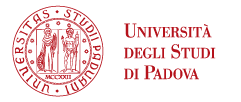
Laboratory for Construction Materials - A Brief History
The Laboratory for Construction Materials was established in 1880, together with the Laboratory for Applied Mechanics of the Royal School of Engineers, annexed to the Chair of Machine Science. It was established by Prof. E. Bernardi, who taught the course in Applied Mechanics from 1878 until 1910, following in the footsteps of Prof. J. Benetti, who had moved to the new School in Bologna.
In 1882, the Laboratory began using its first testing machine, with a capacity of 20 tons, belonging to the Royal Veneto Institute of Sciences.
In 1895, the Laboratory of Applied Mechanics, which had been moved, together with the Laboratory of Technical Physics, in 1886, was again transferred, together with the entire School, to the restored and extended Palazzo ex-Cavalli in the centre of Padova, once occupied by the Customs Office.
In 1910, the Chair of Applied Mechanics was created, and Prof. C. Parvopassu took over the management of the offices and laboratories.
After the First World War, during which the School was occupied by military offices, the Laboratory gradually returned to its normal functions, to meet the demand for reconstruction. First, some laboratories and offices were moved to the new School near Porta Portello. In late 1928 the buildings of the new institute were finished, and in early 1930 the Laboratory started work in its new surroundings in Via Marzolo.
Further equipment arrived in 1939, after the Magistrato alle Acque (the local Water Board) of Venice granted the Laboratory the use of two Losenhausenwerk and Amsler machines, with capacities of 20 and 200 tons respectively. Both were later purchased by the Institute. Very many types of physical and mechanical experiments were then carried out, not only on materials but also on parts of buildings and models.
Although the Second World War inevitably halted further expansion of the Laboratory and in spite of considerable difficulties in financing over this period, two more Losenhausenwerk and Amsler 2-ton and 100-ton machines were purchased, and also a 10-ton Amsler vibraphore.
In 1962 the Institute of Applied Mechanics was subdivided into the Institute of Construction Science, with its own experimental laboratory for testing construction materials, directed by Prof. B. Dall'Aglio, and the Institute of Mechanics Applied to Machines.
In 1964, the Laboratory was further amplified with the addition of a large new hall, extending over the whole of the available space, to house equipment for testing large-scale models and parts of buildings. Finished by 1966, this is a very large room measuring 14 x 25 metres, with a side entrance giving directly on Via Poleni by means of a sliding wall 20 x 7.5 m long. When opened, this wall works with a special 10-ton bridge crane, and structures and even parts of buildings for testing of various kinds can be hoisted from the vehicles on which they arrive directly into the Laboratory.
A 1000-ton Amsler press was also purchased in the 1960s, and later a 300-ton Galdabini press.
In April 1996, the Institute of Construction Science and Techniques, together with the Institute of Road Networks and Transportation and the Institute of Topography, were combined to become the Department of Construction and Transportation.
In the last few years, the Laboratory has been further plentifully equipped with electronic instrumentation and data acquisition systems, to improve measurement precision and to amplify the range of types of testing available.





